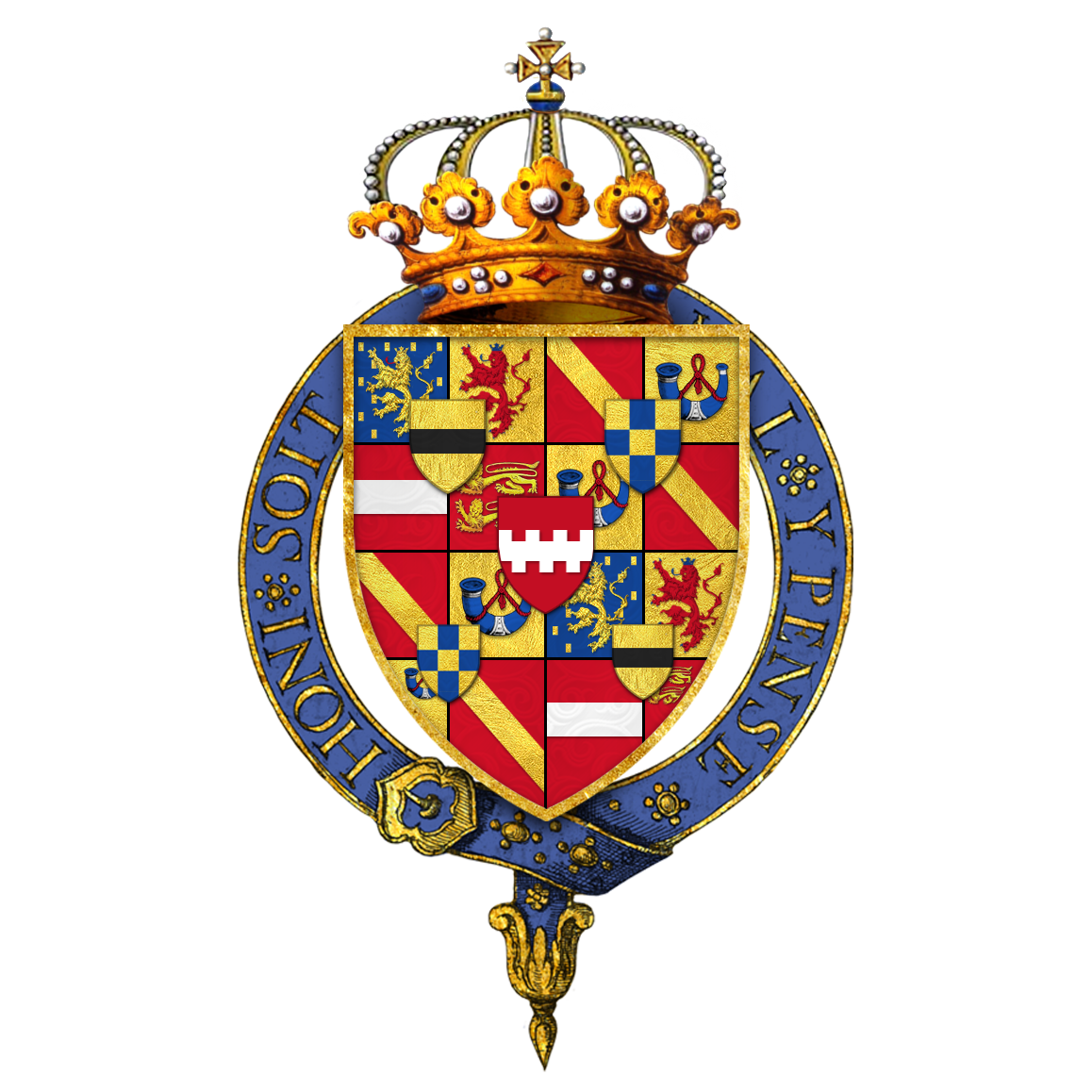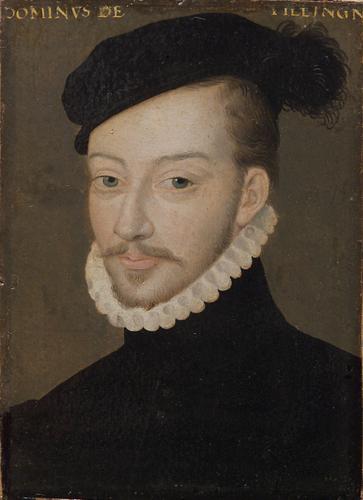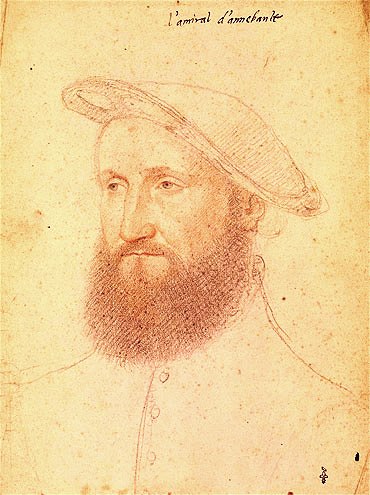|
Charlotte De Laval
Charlotte de Laval, Dame de Châtillon (1530 – 3 March 1568), was a French noblewoman from one of the most powerful families in Brittany. She was the first wife of Gaspard de Coligny, Seigneur de Châtillon, Admiral of France and a prominent Huguenot leader during the French Wars of Religion. She was the mother of Louise de Coligny, the fourth wife of William the Silent, Prince of Orange. The present British Royal Family directly descends from her. Family Charlotte was born in Brittany, France in 1530, the daughter of Guy XVI de Laval, Count of Laval, head of one of Brittany's most powerful noble families, and Antoinette d'Aillon. Her paternal grandparents were Jean de Laval and Jeanne du Perrier, and her maternal grandparents were Jacques d'Aillon and Jeanne Madeleine de Vendôme, Dame d'Illiers. She was a descendant of King Charles VI of France and Isabeau of Bavaria through their daughter Jeanne, Duchess of Brittany. Charlotte's great-aunt was Jeanne de Laval, the sec ... [...More Info...] [...Related Items...] OR: [Wikipedia] [Google] [Baidu] |
Gaspard II De Coligny
Gaspard de Coligny (16 February 1519 – 24 August 1572), Seigneur de Châtillon, was a French nobleman, Admiral of France, and Huguenot leader during the French Wars of Religion. He served under kings Francis I and Henry II during the Italian Wars, attaining great prominence both due to his military skill and his relationship with his uncle, the king's favourite Anne de Montmorency. During the reign of Francis II he converted to Protestantism, becoming a leading noble advocate for the Reformation during the early reign of Charles IX. With the outbreak of civil war in 1562, Coligny joined the Huguenots in their fight against the Crown. He served as a lieutenant to Louis, Prince of Condé throughout the first two civil wars, before becoming the ''de facto'' leader of their military efforts after Condé's death during the third civil war. Due to accusations levelled at him by the assassin of the Catholic Francis, Duke of Guise, in 1563 the powerful Guise family accused ... [...More Info...] [...Related Items...] OR: [Wikipedia] [Google] [Baidu] |
Jeanne De Laval
Jeanne de Laval (10 November 1433 – 19 December 1498), was the second wife and titular Queen consort of René I of Anjou, King of Naples, Sicily, titular King of Jerusalem, Aragon, and Majorca; Duke of Anjou, Bar, and Lorraine; and Count of Provence and Piedmont. Early life Jeanne was born on 10 November 1433 at Auray, Brittany, the daughter of Guy XIV de Laval, Count of Laval and Isabella of Brittany. Her paternal grandparents were Jean de Montfort (who following the dispositions in his marriage contract took the name and arms of the Laval family, assuming the name to Guy XIII of Laval) and Anne de Laval (daughter and heiress of Guy XII de Laval), and her maternal grandparents were John V, Duke of Brittany, and Jeanne of France (daughter of King Charles VI of France and Isabeau of Bavaria). Her father Guy fought with Joan of Arc. His eldest son Francis de Laval, a Grand Master of France, would succeed him as Guy XV, Count of Laval. He had another two sons by his first wif ... [...More Info...] [...Related Items...] OR: [Wikipedia] [Google] [Baidu] |
Battle Of St
A battle is an occurrence of combat in warfare between opposing military units of any number or size. A war usually consists of multiple battles. In general, a battle is a military engagement that is well defined in duration, area, and force commitment. An engagement with only limited commitment between the forces and without decisive results is sometimes called a skirmish. The word "battle" can also be used infrequently to refer to an entire operational campaign, although this usage greatly diverges from its conventional or customary meaning. Generally, the word "battle" is used for such campaigns if referring to a protracted combat encounter in which either one or both of the combatants had the same methods, resources, and strategic objectives throughout the encounter. Some prominent examples of this would be the Battle of the Atlantic, Battle of Britain, and Battle of Stalingrad, all in World War II. Wars and military campaigns are guided by military strategy, whereas ... [...More Info...] [...Related Items...] OR: [Wikipedia] [Google] [Baidu] |
Frederick Henry, Prince Of Orange
Frederick Henry ( nl, Frederik Hendrik; 29 January 1584 – 14 March 1647) was the sovereign prince of Orange and stadtholder of Holland, Zeeland, Utrecht, Guelders, Overijssel in the Dutch Republic from 1625 until his death in 1647. In the last seven years of his life, he was also the stadtholder of Groningen (1640-1647). As the leading soldier in the Dutch wars against Spain, his main achievement was the successful Siege of 's-Hertogenbosch in 1629. It was the main Spanish base and a well-fortified city protected by an experienced Spanish garrison and by formidable water defenses. His strategy was the successful neutralization of the threat of inundation of the area around 's-Hertogenbosch' and his capture of the Spanish storehouse at Wesel. Biography Early life Frederick Henry was born on 29 January 1584 in Delft, Holland, Dutch Republic. He was the youngest child of William the Silent and Louise de Coligny. His father William was stadtholder of Holland, Zeeland, Utrecht, a ... [...More Info...] [...Related Items...] OR: [Wikipedia] [Google] [Baidu] |
Charles De Téligny
Charles de Téligny (c. 153524 August 1572) was a French soldier and diplomat. Biography De Téligny belonged to a respected Huguenot family of Rouerque, and received an excellent training in letters and arms at the house of Gaspard de Coligny. He was employed on several peace missions; he represented the Protestants before the king, and was entrusted by Condé with the presentation of his terms to the queen-mother Catherine in 1567, and in the following year he assisted at the conference at Châlons and signed the Peace of Longjumeau, which was destined to be of short duration. On the outbreak of war, he took part in the siege of Poitiers, directed an unsuccessful attack on Nantes, fought bravely under Coligny at Moncontour, and participated in the negotiations ending in the Peace of Saint-Germain-en-Laye (8 August 1570). In 1571 he retired to La Rochelle and married Louise de Coligny, but was speedily recalled to Paris to serve on the bi-partisan commission of adjustment. ... [...More Info...] [...Related Items...] OR: [Wikipedia] [Google] [Baidu] |
Château De Châtillon-Coligny
The Château de Châtillon-Coligny is a castle, later replaced with a smaller château, in the ''commune'' of Châtillon-Coligny in the Loiret ''département'' of France. The present structure is heavily modified. Its origins were a medieval fortress whose keep was constructed around 1180. The castle was rebuilt during the Renaissance and demolished from 1798. A new, more modest château was constructed in 1854. Of the original, the keep and a Renaissance well, attributed to Jean Goujon, are the only remains. Location The castle is built on a plateau dominating the Loing valley. History *1059: Châtillon was a ''castrum'' held by the counts of Blois; it was a simple wooden tower, known as ''Castri Castellionis'' around 1120. *1143: It was destroyed by Louis VII and the Châtillon family died out. In the mid-12th century, the Champagne family took over the land. *c1180 The keep was erected by Etienne I de Sancerre. The polygonal tower has six faces with buttresses in alternate corn ... [...More Info...] [...Related Items...] OR: [Wikipedia] [Google] [Baidu] |
Claude D'Annebault
Claude d'Annebault (1495 – 2 November 1552) was a French military officer; Marshal of France (1538–52); Admiral of France (1543–1552); and Governor of Piedmont in 1541. He led the French invasion of the Isle of Wight in 1545. Annebault was governor of Normandy and a very powerful figure during the reign of King Francis. Claude was a commissioner for the Anglo-French Treaty of Ardres, also known as the Treaty of Camp, which was signed on 7 June 1546 and a step towards the conclusion of the Italian War of 1542–1546. After a delay which the English found frustrating, Claude then visited England as a special ambassador for the peace treaty 20–30 August 1546. Four cannon at Walmer Castle burst while firing his salute. Claude wrote from London to his ally, Mary of Guise, in Scotland on 28 August, explaining his difficulties in forwarding their mutual interest. Family Claude married Françoise Tournemine, daughter and heiress of George, sieur de la Hunaudaye. Their only son Jea ... [...More Info...] [...Related Items...] OR: [Wikipedia] [Google] [Baidu] |
Fontainebleau
Fontainebleau (; ) is a commune in the metropolitan area of Paris, France. It is located south-southeast of the centre of Paris. Fontainebleau is a sub-prefecture of the Seine-et-Marne department, and it is the seat of the ''arrondissement'' of Fontainebleau. The commune has the largest land area in the Île-de-France region; it is the only one to cover a larger area than Paris itself. The commune is closest to Seine-et-Marne Prefecture, Melun. Fontainebleau, together with the neighbouring commune of Avon and three other smaller communes, form an urban area of 36,724 inhabitants (2018). This urban area is a satellite of Paris. Fontainebleau is renowned for the large and scenic forest of Fontainebleau, a favourite weekend getaway for Parisians, as well as for the historic Château de Fontainebleau, which once belonged to the kings of France. It is also the home of INSEAD, one of the world's most elite business schools. Inhabitants of Fontainebleau are sometimes called '' ... [...More Info...] [...Related Items...] OR: [Wikipedia] [Google] [Baidu] |
François Clouet - Admiral Gaspard II De Coligny
François () is a French masculine given name and surname, equivalent to the English name Francis. People with the given name * Francis I of France, King of France (), known as "the Father and Restorer of Letters" * Francis II of France, King of France and King consort of Scots (), known as the husband of Mary Stuart, Queen of Scots * François Amoudruz (1926–2020), French resistance fighter * François-Marie Arouet (better known as Voltaire; 1694–1778), French Enlightenment writer, historian, and philosopher *François Aubry (other), several people *François Baby (other), several people * François Beauchemin (born 1980), Canadian ice hockey player for the Anaheim Duck * François Blanc (1806–1877), French entrepreneur and operator of casinos * François Boucher (other), several people * François Caron (other), several people * François Cevert (1944–1973), French racing driver * François Chau (born 1959), Cambodian American acto ... [...More Info...] [...Related Items...] OR: [Wikipedia] [Google] [Baidu] |
Governor Of Brittany
This page is a list of royal governors of Brittany during the Ancien Régime. *Nominoe (9th century) *Enguerrand VII, Lord of Coucy (1380–?) *Jean de Laval, husband of Françoise de Foix (16th century) *Jean IV de Brosse (16th century) *Louis III de Bourbon, Duke of Montpensier (1569–1582) *Philippe Emmanuel, Duke of Mercœur (1582–1598) *César de Bourbon, Duke of Vendôme (1608–1626) *Armand-Jean du Plessis, Cardinal Richelieu (1626–1642) *François Louis de Rousselet, Marquis de Châteaurenault (1704–?) *Louis-Alexandre de Bourbon, Comte de Toulouse (?–1737) *Louis Jean Marie de Bourbon, Duke of Penthièvre Louis Jean Marie de Bourbon (16 November 1725 – 4 March 1793) was the son of Louis Alexandre de Bourbon and his wife Marie Victoire de Noailles. He was therefore a grandson of Louis XIV of France and his mistress, Madame de Montespan. From ... (1737–?) * Emmanuel-Armand de Richelieu, Duke of Aiguillon (1753 – c. 1770) History of Brittany Politics ... [...More Info...] [...Related Items...] OR: [Wikipedia] [Google] [Baidu] |
Charlotte Of Naples
Charlotte of Naples ( – 1506), also known as Charlotte of Aragon and Princess of Taranto, was the eldest daughter and eventual heiress of King Frederick of Naples. Although her father was dispossessed of his kingdom, her descendants, the House of La Trémoïlle maintained their dynastic claim in exile. Daughter of the Neapolitan king's first marriage to Anne of Savoy, a granddaughter of Charles VII of France, Charlotte was married to Guy XVI, Count of Laval, head of one of Brittany's most powerful noble families. Marriage Following her mother's death which occurred shortly after her birth, Charlotte was raised in France and brought up at the French court. One of her suitors was Cesare Borgia. Charlotte refused him, and instead on 10 June 1500 married Guy XVI de Laval, Count of Laval. Charlotte and Guy had: *Catherine, married Claude I of Rieux *Anne, married François de la Trémoïlle *François, d.1522 Claim to kingdom of Naples In the year following Charlotte's marriage, he ... [...More Info...] [...Related Items...] OR: [Wikipedia] [Google] [Baidu] |




